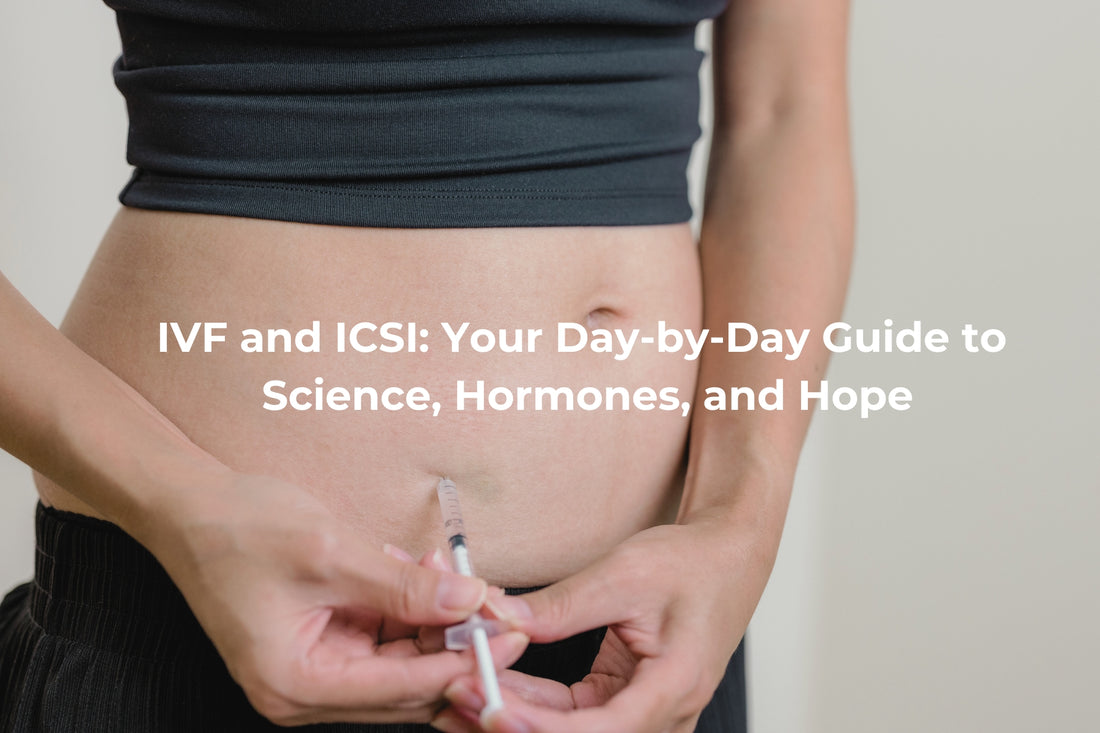
IVF and ICSI : Your Day-by-Day Guide to Science, Hormones, and Hope
Before We Start: A Quick Disclaimer
This is a very rough guide to give you an idea of what IVF and ICSI might look like. Every clinic has its own protocols, and every person’s body responds differently to treatment. Some cycles are faster, some slower. Some involve additional medications, tests, or delays. Think of this as the “general vibe” of what to expect—your doctor will tailor the details to fit your situation.
IVF and ICSI can feel overwhelming, but breaking it down day by day can help. So, grab a snack, take a deep breath, and let’s walk through this wild but hopeful journey together.
Day 1: The Baseline Check – “Start Line, Ready!”
- You roll into the clinic, where they draw blood and scan your ovaries (hello again, ultrasound wand).
- Goal? Make sure your ovaries are “quiet” and ready to kickstart the cycle.
- Mood: Excited but nervous. Is this where babies start? Yes. Yes, it is.
Day 2: Shots Begin – “Needles R Us”
- It’s hormone injection day! You start with:
- FSH (e.g., Gonal-F): The “grow, follicles, grow” shot.
- Menopur: Boosts follicle stimulation and egg quality (but also stings like betrayal).
- If you’re doing this for the first time, the phrase “self-administered injections” might sound terrifying. Don’t worry—you’ll soon become a pro.
Days 3–7: “Follicle Farms Open for Business”
- The shots continue morning and evening. You’re growing eggs like you’re in a follicle competition (because you are).
- New Addition: By Day 6 or 7, you’ll start the Ganirelix or Cetrotide shot to stop premature ovulation.
-
Clinic Check-Ins: Bloodwork + wand ultrasounds track your follicle sizes.
- Doc says, “Follicles at 12–14mm, keep going!”
- You smile like you know what that means (but you still don’t).
- Mood: Bloated. Slightly cranky. Wondering why leggings aren’t the official IVF uniform.
Day 8–12: Trigger Shot – “The Ovary Finale”
- When your follicles hit 18–20mm, it’s trigger shot time! This injection tells your eggs to mature and prepare for the egg retrieval.
- You’ll set 17 alarms because timing is EVERYTHING. (Seriously, this is not the time for “oops.”)
- Mood: Nervous/excited. It’s like the night before a big exam, but your ovaries are the ones doing the work.
Day 13: Egg Retrieval – “Snooze While Science Collects”
- You’re sedated (hello, nap time), while the doctor retrieves eggs with a fine needle through your ovaries.
-
The Result? A count of how many eggs were collected.
- “We got 12 eggs!” Cue your victory dance (cramps and all).
- Mood: Groggy, crampy, but proud. Eggs = gold.
Now Let’s Talk ICSI: “Where Science Gets Hands-On”
(Intracytoplasmic Sperm Injection—because sometimes sperm needs a little encouragement.)
What is ICSI?
- Instead of letting sperm and egg “figure it out” in a dish like traditional IVF, ICSI takes over.
- The embryologist picks the best-looking sperm (think: sperm Olympics champion) and injects it directly into the egg with a tiny needle.
-
Why do ICSI?
- If sperm count, movement, or shape needs a boost.
- If previous fertilization failed.
- When you want to maximize fertilization chances because—let’s be real—every egg counts.
The Fertilization Update
-
Day 1 After Retrieval: The clinic calls with fertilization results.
- Example: “12 eggs retrieved, 10 mature, 8 fertilized with ICSI.” Cue the fist pump.
- ICSI works its magic on eggs that might not have fertilized otherwise, giving you a better shot at embryos.
Days 14–19: Embryo Updates – “Growing Tiny Humans in a Lab”
- Over the next 5 days, embryos divide and grow into blastocysts.
- Day 1: Fertilized eggs.
- Day 3: The embryos are dividing.
- Day 5: The strongest embryos reach blastocyst stage.
Two Paths: Fresh vs. Frozen Transfer
Fresh Embryo Transfer
- If your body is ready, you’ll do a fresh embryo transfer on 5 after retrieval.
- The doctor gently places one of your best embryos in your uterus. Quick. Magical. Painless.
- Mood: Hopeful and hormonal.
Frozen Embryo Transfer (FET)
- If your hormone levels are too high or you need time to recover, embryos are frozen.
-
The FET Process (Weeks Later):
- Uterine Prep: Estrogen pills/patches thicken your lining.
- Progesterone Injections: You’ll stab yourself in the butt (it stings, but you’re tough).
- Transfer Day: The frozen embryo gets thawed and transferred into your uterus. Like it never left.
The Dreaded Two-Week Wait – “Symptom Over analysis Olympics”
- Whether fresh or frozen, you now enter the TWW (Two-Week Wait).
- Every cramp, sneeze, or weird food craving feels like a sign.
- Mood: Hopeful, anxious, and Googling “early pregnancy symptoms” at 2 a.m.
Beta Day: “Did it Work?!”
- Blood test day. They’ll check your beta-HCG levels to confirm pregnancy.
- Positive? Break out the tissues—you did it.
- Negative? It’s devastating. IVF is tough. Take the time you need, cry it out, and remember—this isn’t the end.
Final Thoughts: Why You’re a Total Legend
IVF—especially with ICSI—means you’re combining science, strength, and hope. Every needle, every appointment, and every step gets you closer to your dream.
Whether it works this time or not, you are a warrior. You’ve shown up, fought hard, and proven that your courage knows no limits.
Science + Hope + You = A Damn Good Team.
